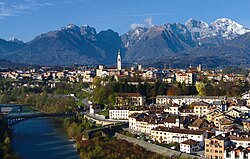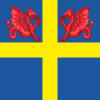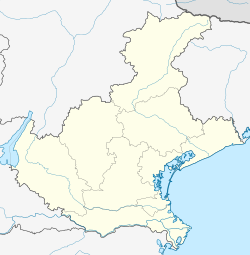Belluno
This article needs additional citations for verification. (August 2020) |
Belluno
| |
|---|---|
| Città di Belluno | |
 Panorama of Belluno | |
| Coordinates: 46°08′25″N 12°13′00″E / 46.14028°N 12.21667°E | |
| Country | Italy |
| Region | Veneto |
| Province | Belluno (BL) |
| Frazioni | see list |
| Government | |
| • Mayor | Oscar de Pellegrin |
| Area | |
• Total | 147.18 km2 (56.83 sq mi) |
| Elevation | 390 m (1,280 ft) |
| Population (January 2017)[2] | |
• Total | 35,876 |
| • Density | 240/km2 (630/sq mi) |
| Demonym | Bellunesi |
| Time zone | UTC+1 (CET) |
| • Summer (DST) | UTC+2 (CEST) |
| Postal code | 32100 |
| Dialing code | 0437 |
| Patron saint | Saint Martin |
| Saint day | 11 November |
| Website | Official website |


Belluno (Italian pronunciation: [belˈluːno] ; Ladin: Belum; Venetian: Belùn) is a town and province in the Veneto region of northern Italy. Located about 100 kilometres (62 miles) north of Venice, Belluno is the capital of the province of Belluno and the most important city in the Eastern Dolomites region. With its roughly 36,000 inhabitants, it is the largest populated area of Valbelluna. It is one of the 15 municipalities of the Dolomiti Bellunesi National Park.
Geography
[edit]The ancient city of Belluno rises above a cliff spur near the confluence of the Torrente Ardo and the Piave River. To the north is the imposing Schiara range of the Dolomites, with the famous Gusela del Vescovà (Bishopric's needle), and mountains Serva and Talvena rising above the city. To the south, the Venetian Prealps separate Belluno from the Venetian plain. Also to the south is the Nevegal, in the Castionese area, a skiing resort.
History
[edit]The name of the city is derived from Celtic belo-dunum which means "shining hill."[3]
It is conjectured that the population of the area that became Belluno was largely Venetic with a strong Celtic minority. However, as the Romans expanded northward into the Alps, the Celtic either emigrated or were absorbed. The people of the area swore friendship to Rome in the 225 BC conflict with the Gauls and again during the invasion by Hannibal in the Second Punic War.
Founded perhaps around 220-200 BC the initial influence of Rome was military and commercial. Strategically located, the town protected cities to the south. Belluno also became a supplier of iron and copper. Already within the Roman sphere of influence, the town was juridically and politically incorporated into the Roman Republic by the second century BC.
Sometime between the death of Julius Caesar and the ascent of Augustus, Bellunum became a Roman municipium and its people were ascribed to the Roman tribe Papiria. The town was ruled by quattorviri juri dicendo, by quattorviri aedilicia potestate, and by a Council of Elders. Under Augustus, it became part of Regio X Venetia et Histria. Among its citizens were Caius Flavius Hostilius and his wife Domitia, whose 3rd century sarcophagus lies next to the church of San Stefano.
After the fall of the Western Roman Empire, it was ruled by the Lombards (6th century) and the Carolingians (8th century); the famous Belluno Treasure in the British Museum dates from this period. From the late 9th century it was ruled by a count-bishop and it received a castle and a line of walls. Later it was a possession of the Ghibelline family of the Ezzelino. After having long contended the nearby territory with Treviso, in the end Belluno gave itself to the Republic of Venice (1404). The city was thenceforth an important hub for the transport of lumber from the Cadore through the Piave river. It remained Venetian until 1797.[4]
After the fall of the Venetian Republic, Belluno was an Austrian possession, until it was annexed to the Kingdom of Italy in 1866.
The cathedral was severely damaged by the earthquake of 1873, which destroyed a considerable portion of the town, though the campanile stood firm.[4]
Main sights
[edit]- The Duomo (Cathedral, 16th century), with the 18th-century bell tower designed by Filippo Juvarra. The church's plan is attributed to the Venetian architect Tullio Lombardo
- Palazzo dei Rettori (1491)
- The red edifice of the Communal Palace
- The Bishop's Palace, erected in 1190 by the count-bishop Gerardo de' Taccoli
- The Fountain of Piazza del Duomo
- Baroque church of San Pietro (1326), originally in Gothic style. It includes five paintings by Andrea Schiavone, three by Sebastiano Ricci.
- Palazzo del Capitano
- The 16th-century church of San Rocco
- Santo Stefano church, housing several 15th-century paintings by local masters. It also includes an Adoration of the Magi, from Tiziano's workshop.
- The Romanesque church of San Biagio
- Porta Dojona and Porta Rugo: gates in the ancient walls
- Santa Maria dei Battuti: 16th-century church
Government
[edit]Frazioni
[edit]Antole, Bes, Bolzano Bellunese, Caleipo-Sossai, Castion, Castoi, Cavessago, Cavarzano, Cet, Chiesurazza, Cirvoi, Col di Piana, Col di Salce, Collungo, Cusighe, Faverga, Fiammoi, Giamosa, Giazzoi, Levego, Madeago, Miér, Nevegal, Orzes, Pedeserva, Pra de Luni, Rivamaor, Safforze, Sala, Salce, San Pietro in Campo, Sargnano, Sois, Sopracroda, Sossai, Tassei, Tisoi, Vezzano, Vignole, Visome.
Quarters
[edit]Baldenich, Borgo Garibaldi (or Via Garibaldi), Borgo Piave, Borgo Prà, Cavarzano, Lambioi, Mussoi, Quartier Cadore, San Lorenzo, San Pellegrino, San Francesco, Via Cairoli, Via Feltre-Maraga, Via Montegrappa.
Climate
[edit]Belluno has a warm-summer humid continental climate (Köppen climate classification: Dfb). The average annual temperature is 10.8 °C (51 °F), and the average annual precipitation is 1,128 mm (44 in).
| Climate data for Belluno, Italy | |||||||||||||
|---|---|---|---|---|---|---|---|---|---|---|---|---|---|
| Month | Jan | Feb | Mar | Apr | May | Jun | Jul | Aug | Sep | Oct | Nov | Dec | Year |
| Mean daily maximum °C (°F) | 3.3 (37.9) |
6.2 (43.2) |
11.1 (52.0) |
15.5 (59.9) |
19.9 (67.8) |
24.0 (75.2) |
26.5 (79.7) |
26.0 (78.8) |
22.4 (72.3) |
16.3 (61.3) |
9.6 (49.3) |
4.5 (40.1) |
15.4 (59.8) |
| Daily mean °C (°F) | −0.4 (31.3) |
1.9 (35.4) |
6.5 (43.7) |
10.7 (51.3) |
14.9 (58.8) |
18.7 (65.7) |
20.9 (69.6) |
20.5 (68.9) |
17.3 (63.1) |
11.8 (53.2) |
5.9 (42.6) |
1.2 (34.2) |
10.8 (51.5) |
| Mean daily minimum °C (°F) | −4.1 (24.6) |
−2.4 (27.7) |
1.8 (35.2) |
5.9 (42.6) |
9.9 (49.8) |
13.4 (56.1) |
15.3 (59.5) |
14.9 (58.8) |
12.2 (54.0) |
7.3 (45.1) |
2.1 (35.8) |
−2.2 (28.0) |
6.2 (43.1) |
| Average precipitation mm (inches) | 45 (1.8) |
52 (2.0) |
77 (3.0) |
97 (3.8) |
130 (5.1) |
120 (4.7) |
115 (4.5) |
102 (4.0) |
98 (3.9) |
116 (4.6) |
105 (4.1) |
71 (2.8) |
1,128 (44.3) |
| Average precipitation days | 5 | 5 | 7 | 11 | 13 | 13 | 11 | 10 | 8 | 9 | 8 | 6 | 106 |
| Source: Enea[5] | |||||||||||||
Transport
[edit]State roads lead from Belluno to Feltre, Treviso, Ponte nelle Alpi and Vittorio Veneto.
Belluno railway station, at Piazzale della Stazione, forms part of the Calalzo–Padua railway. It was opened in 1912, replacing an earlier station opened in 1886. Its passenger building, designed by the architect Roberto Narducci, was constructed in 1928.
The bus station is also at the Piazzale della Stazione, next to the railway station.
Notable residents
[edit]- Marco Paolini (b. 1956), stage actor
- Dino Buzzati (1906–1972), novelist and journalist, born in Belluno
- Pope Gregory XVI (1765–1846)
- Andrea Brustolon (1662–1732), sculptor
- Ippolito Caffi (1809–1866), painter
- Sebastiano Ricci (1659–1734), painter
- Marco Ricci (1676–1730), painter
- Luigi Luca Cavalli-Sforza (1922–2018), human geneticist and pioneer of the Human Genome Diversity Project, resided and died in Belluno[6]
- Pope John Paul I (1912–1978)
- Bernardino Vitulini, painter
- Charles DeRudio, Italian aristocrat and later American soldier who fought in the 7th U.S. Cavalry at the Battle of the Little Bighorn.
International relations
[edit]Belluno is twinned with:
 Cervia, Italy
Cervia, Italy Bend, United States
Bend, United States
See also
[edit]- Province of Belluno
- Dolomiti Bellunesi National Park
- Roman Catholic Diocese of Belluno-Feltre
- Col Visentin
References
[edit]- ^ "Superficie di Comuni Province e Regioni italiane al 9 ottobre 2011". Italian National Institute of Statistics. Retrieved 16 March 2019.
- ^ "Popolazione Residente al 1° Gennaio 2018". Italian National Institute of Statistics. Retrieved 16 March 2019.
- ^ "Belluno (BL), Veneto, Italy". www.italyheritage.com. Retrieved 2023-08-21.
- ^ a b One or more of the preceding sentences incorporates text from a publication now in the public domain: Chisholm, Hugh, ed. (1911). "Belluno". Encyclopædia Britannica. Vol. 3 (11th ed.). Cambridge University Press. p. 710.
- ^ "Profilo climatico Belluno". Enea. 2020. Archived from the original on 2016-03-05. Retrieved 2020-06-24. Retrieved on June 24, 2020.
- ^ Grady, Denise (2018-09-19). "Luigi Cavalli-Sforza, 96, Who Tracked Genes Through History, Dies". The New York Times. ISSN 0362-4331. Archived from the original on 2020-11-15. Retrieved 2020-11-15.





